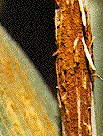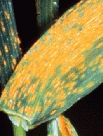
| 
| 
| 
|
| Stem Rust | Leaf Rust | Stripe Rust | Crown Rust |
Data about Rust in GrainGenes
Markers and protocols for rust resistance genes
At the MASwheat site
Map locations of rust resistance genes
Sequenced rust resistance genes
Stem Rust Race Ug99
In Uganda in 1999 a new race of the wheat stem rust pathogen arose, a race that is virulent against Sr31, the most widely deployed resistance gene worldwide. The potential impact of this new race is becoming clear as more information is gathered. On 9 September 2005 the Global Rust Initiative was established to respond to this threat.
Research data:
- Stem rust evaluations of nursery entries in Njoro, Kenya
Ug99 reactions of all wheat and barley lines in the 2005-2008 nurseries. From the USDA-ARS Cereal Disease Laboratory. - Stem Rust Resistance (Sr) Genes
Documentation of all known Sr genes. From the USDA-ARS CDL. - Molecular markers for Sr genes
From the MASWheat project.
Published results and analysis:
- Singh et al., 2006. Current status, likely migration and strategies to mitigate the threat to wheat production from race Ug99 (TTKS) of stem rust pathogen.
A thorough review of the current status as of October 2006. - Jin and Singh, 2006. Resistance in U.S. Wheat to Recent Eastern African Isolates of Puccinia graminis f. sp. tritici with Virulence to Resistance Gene Sr31
Results from the 2005 Kenya nursery, screening 450 wheat lines. - R.P. Singh et al. 2005. Spread of a Highly Virulent Race of Puccinia graminis tritici in Eastern Africa (pdf, 46 KB)
Resistance genes that are effective against Ug99, and which ones are likely to be useful. - Expert Panel, 2005. Sounding the Alarm on Global Stem Rust (pdf, 200 KB)
Report of the Expert Panel on the Stem Rust Outbreak in Eastern Africa, May 2005. Background, threat assessment, and control strategies.
News reports:
- Red Menace: Stop the Ug99 Fungus Before Its Spores Bring Starvation, Wired Magazine, Mar 10
- Fighting a Worldwide Wheat Threat, USDA-ARS, 16 Jun 08
- ARS, Cooperators Fight New Strain of Wheat Stem Rust, USDA-ARS, 01 Feb 06
- Wheat Warning -- New Rust Could Spread Like Wildfire, Science News Online, 24 Sep 05
- Global Rust Initiative: Safeguarding the World's Wheat Production, CGIAR, 29 Sep 05
Rust Disease in Cereals
Rust diseases are caused by fungi in class Basidiomycetes, with complex life cycles that require annual alternating stages of attack on two unrelated plant species. The rust fungi, mainly genus Puccinia, have co-evolved intensively with their hosts, leading to hundreds of resistance genes in the plant, each of which responds to a specific "avirulence" gene in the fungus.
Control of rust diseases relies on these resistance genes. Chemical control with fungicides is not used, not economically practical. Our defense against rusts depends on breeding the currently effective resistance genes into every variety distributed to our farmers, worldwide.
The ARS Cereal Disease Laboratory (CDL) is a main resource for tracking these diseases and has a mission to reduce losses to these and other pathogens in wheat, oat, and barley.
The American Phytopathological Society (APS) has a fine Plant Disease Lesson on stem rust.
Stem Rust (Puccinia graminis)
This pathogen is generally known on wheat and barley as Puccinia graminis f.sp. tritici, on oat as P. graminis f.sp.
avenae, and on rye as P. graminis f.sp. secale. In wheat there are more than 60 genes known for resistance to this pathogen. This pathogen is of critical concern on wheat because a long known source of resistance (Sr31) has been shown susceptible to a new race of the pathogen called Ug99 originally seen in Uganda in 1999. Please see news items mentioned above.
- Background information from CDL on Black Stem Rust and threat to wheat growers
- List of Stem Rust Resistance (Sr) Genes maintained by the CDL
- Stem Rust Resistance (Sr) Genes listed in GrainGenes
Leaf Rust (Puccinia triticina)
This pathogen is generally known on wheat as Puccinia triticina (formerly known as P. recondita f.sp. tritici), on barley as P. hordei, and on rye as P. recondita f.sp. secalis. In wheat there are more than 45 genes known for resistance to this pathogen.
- Background information from CDL on Wheat Leaf Rust
- Leaf Rust Resistance (Lr) Genes listed in GrainGenes
- Leaf Rust Resistance (Rph) Genes listed in GrainGenes
Stripe Rust (Puccinia striiformis)
This is a major disease of fall seeded wheat in regions with cool nights or of spring wheat planted adjacent to infected fall seeded wheat. Severe losses result when spikes are infected with losses of 40 percent common, and with some fields totally destroyed.
- Background information from CDL on Wheat Stripe Rust
- Stripe Rust Resistance (Yr) Genes listed in GrainGenes
- Stripe Rust Resistance (Rps) Genes listed in GrainGenes
Crown Rust (Puccinia coronata)
This pathogen is generally occurs on oat as Puccinia coronata f.sp. avenae, but also occurs on barley as P. coronata f.sp. hordei. Over 100 genes for resistance have been characterized for this pathogen in oat.
- Background information from CDL on Oat Crown Rust
- Background information from CDL on Barley Crown Rust
- Crown Rust Resistance (Pc) Genes listed in GrainGenes
Monitoring Cereal Rusts
As mentioned above, the ARS Cereal Disease Laboratory maintains records of the occurrences of rust disease in the United States and abroad. As part of this service periodic bulletins, the Cereal Rust Bulletins, are released and archived here. There is also a cereal rust survey mailing list used by staff and cooperators to provide the latest rust situation reports. The URL for joining the mailist (currently at 180 subscribers) is HERE.
The International Maize and Wheat Improvement Center (CIMMYT) and International Center for Agricultural Research in the Dry Areas (ICARDA) are also involved in preserving worldwide germplasm and have brought attention to the potential threat of new races of cereal rust pathogens. Please see the Expert Panel Report (29 May 05) explaining the threat of new rust races on the cereals.
Measures have been implemented to attempt keeping the pathogen spread in check by establishing plant and seed transport quarantines. Please see USDA-APHIS Pest Detection and Management Programs.
